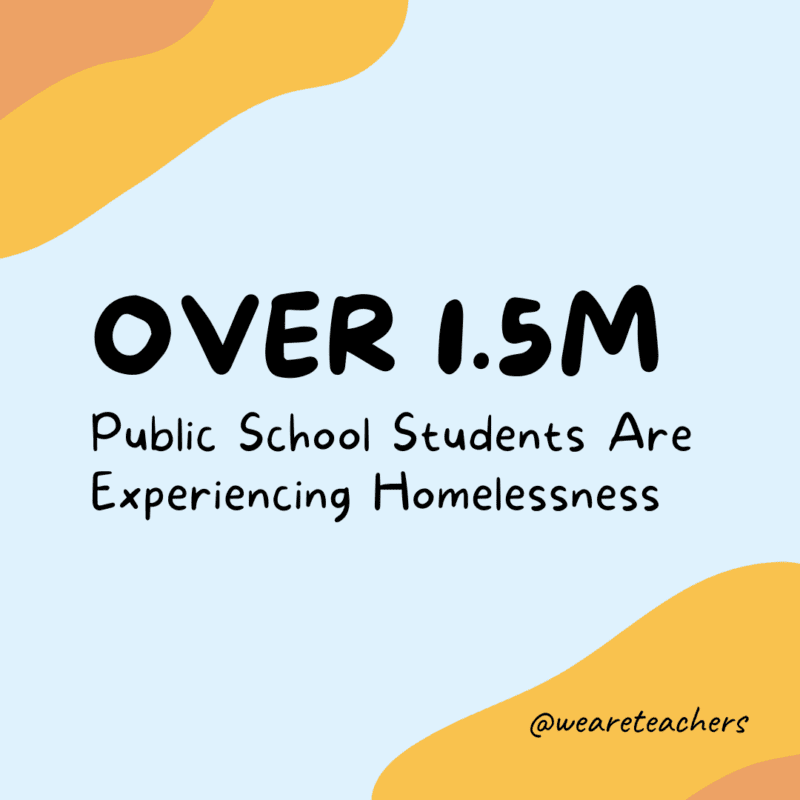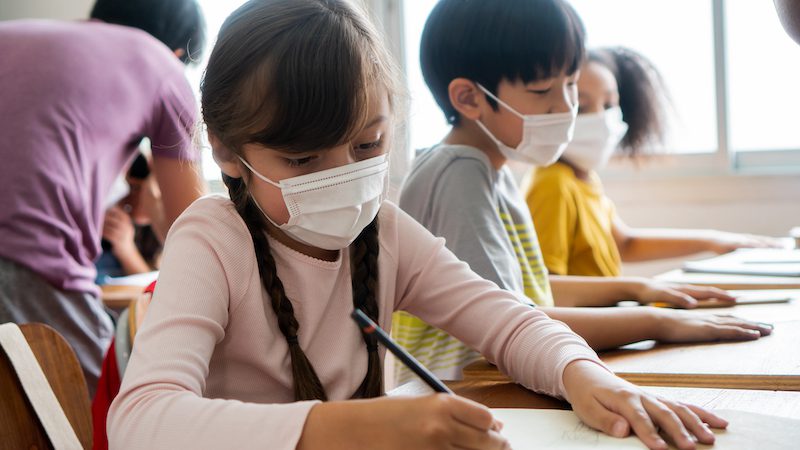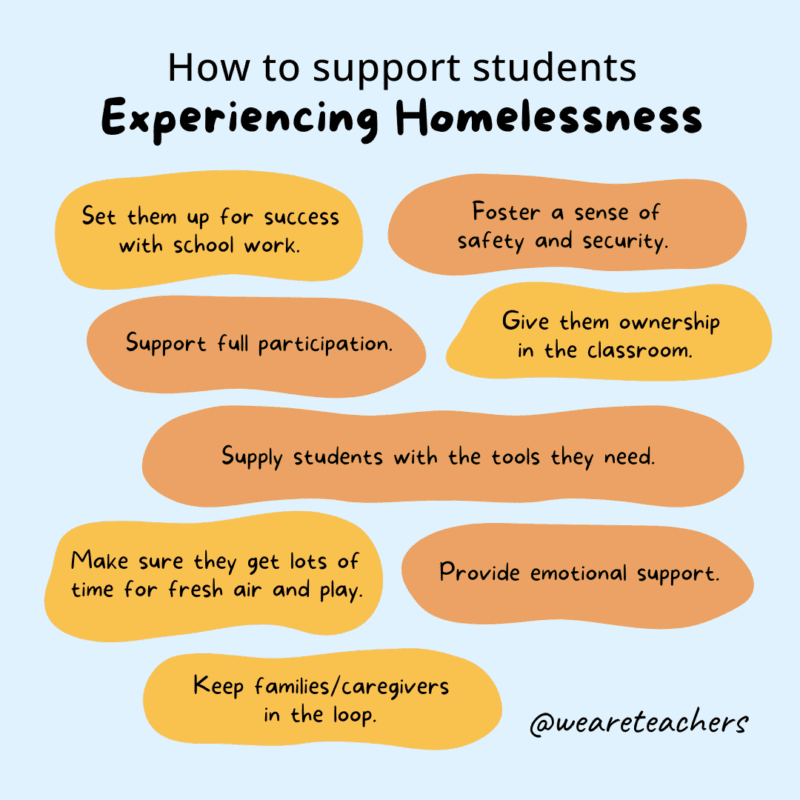It’s a heartbreaking fact that over 1.5 million public school students are experiencing homelessness in the U.S., according to the latest statistics. That means, at some point during an educator’s career, it’s likely they will have a student in their class who is affected by these circumstances.

Fourth grade teacher Megan N. is one of those teachers. She wrote into our WeAreTeachers Helpline group on Facebook, asking for advice from colleagues. “I am getting a new student on Monday who is homeless,” she wrote. “I’ve never had a student experiencing homelessness before. This is his 3rd school this year. How can I make him feel like my classroom is his safe place to land?”
The classroom and a relationship with a caring teacher can be a powerful force in helping students feel safe and important and to provide much-needed stability in their lives. But not all teachers know exactly what to do or how to do it in order to help support these students. Here are a few tips to keep in mind, plus advice from classroom teachers who’ve been there.
Welcome the child into your classroom community
The personal relationships kids build at school can be critical to their survival. Begin by getting to know them as an individual and work to build their trust. Regularly check in to see how you can offer emotional and academic support. Offer encouragement and understanding and build them up by recognizing their talents and accomplishments.
Teachers say:
Just love him and make him feel as welcome as you can. He wants to feel like he has a place to fit in. —Ann B.
A lot of homeless kids are too proud or too embarrassed to ask for what they need, so keep an eye on him to see what his needs are and be patient. It’ll take time for him to trust you. —Janet G.
Most important, above all else, show him love and respect. Compassion will get both of you off on the right foot. —Angela B.
Foster a sense of safety and security
One thing a child who is experiencing homelessness needs more than anything is a predictable, reliable routine at school. Their home lives may feel chaotic, and school is often their safe haven. Adhere to a consistent daily routine with clear, concise rules. Provide well-defined transition procedures from one activity to another. Plan ahead whenever possible, and inform students ahead of time about substitute teachers and changes in activities.
Teachers say:
His physical, social, and emotional needs need to be met before even trying to expect anything from him academically. —Myrna L.
I would worry more about building his life skills and social skills before academics. Make him feel important and loved. —Lyssa I.
Give them ownership in the classroom
Children experiencing homelessness often feel a profound lack of control. Empower them by giving them something that they can call their own: a defined space, a plant to take care of, a class pet to feed, a job to do. Make an exception, and allow the student to hang onto personal possessions. Keep in mind that any possession may be the child’s only one.
Teachers say:
We have a safe place in our room with comfort items like pillows (in case they find they need to rest because there is not a place to safely rest outside of school), a small rug to sit on, a few stuffed animals, and even some play dough that they can squeeze if they need to. —Angela B.
I would provide a place for this student to leave his school work and school supplies, so he doesn’t have to lug around a bunch of stuff. —Tuesday D.
Make sure they get lots of time for fresh air and play
Draw the line at taking away recess as a disciplinary consequence. For many homeless children, school may be the only place they have to run and play. The playground is also where they may begin to connect with classmates and make new friends.
Set them up for success with school work
Plan your assignments so children can keep up without having to take work home. Break projects into smaller components to ensure students can have success. The experience of mastery with their schoolwork is critical to their self-image. Make arrangements for additional tutoring/ academic help if needed. If you have an after school homework club where they can get one-on-one attention, encourage them to attend.
Teachers say:
Minimize homework if possible, and offer help before or after school or at lunch to do it. —Susan M.
Check in with the librarian; they might need a little extra help accessing technology to complete projects. —Amy Y.
Supply students with the tools they need.
Supplies like paper, pencils, markers, scissors, etc., may not be available for the child in their current living situation. They may not have access to a workspace either. Provide your student with a backpack with the work supplies they need and a clipboard to take home as a portable desk. In addition, keep a supply of extra toiletry items on hand in case they need a toothbrush or comb and nutritional snacks for snack time.
Teachers say:
Offer him supplies and food, but you may need to try and not be too solicitous. It may not be the case with younger kids, but sometimes older kids don’t always react well to being treated differently. —Susan C.
Support full participation
Make sure that all of your students have access to opportunities, regardless of their living situation. Work with your administration to secure the funds, materials, and transportation required for students to participate in field trips, after-school activities, and class projects.
Teachers say:
Whenever I have students who need extra help, I put them to work in my room. The job is something simple like turning on the computers in the morning and off in the afternoon or grading papers. This allows me to pay for the things they need without them feeling like it’s pity or a handout. —Carol L.
Provide emotional support
It goes without saying: homelessness is a scary situation. It is critical for children experiencing it to have access to mental health professionals at school. Make room for them to express their fears and frustrations and give opportunities to do so in a comfortable way—talking, writing, drawing. Help them find positive outlets for anger, and give them choices, when appropriate, to counter the loss of control they feel. The experience of homelessness can be traumatizing. Be aware of triggers that may set students off.
Teachers say:
Give lots of positive reinforcement, and be there for him to talk to. Show him that people care. —Caroline L.
Always point out good things about him. Help build his self-esteem. —Rachael A.
Keep families/caregivers in the loop
When you welcome a child experiencing homelessness into your classroom, extend your support to their family as well. Send home a packet for parents or caregivers with school and classroom rules, lunch menu, class schedule, calendar of events, etc. Send weekly progress reports and encouraging notes. Because parents may not have regular access to a phone, create a communication plan that works best for them.
Teachers say:
I would send the family a welcome letter and invite them to visit the classroom. Ask if younger siblings need supportive services. Make sure parents know their family’s rights. —Marri M.
Learn more
It’s important for classroom teachers to educate themselves on the issue of homelessness as it relates to their students. The McKinney-Vento Homeless Assistance Act, a federal law passed in 1987, entitles homeless children to a free and appropriate public education. It requires schools to eliminate barriers to their enrollment, attendance, and success in school and sets aside Title I funds specifically for their support.
In addition, powerful organizations that work to support and advocate for students experiencing homelessness include SchoolHouse Connection, the National Center for Homeless Education, National Coalition for the Homeless, and the National Association for the Education of Homeless Children and Youth.
Plus, read 5 things foster youth want all teachers to know.



